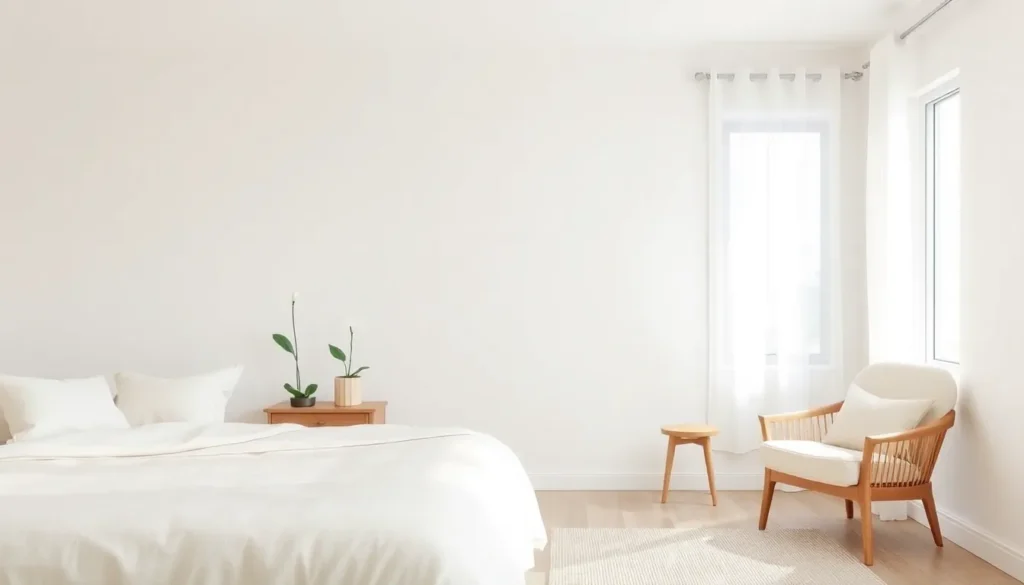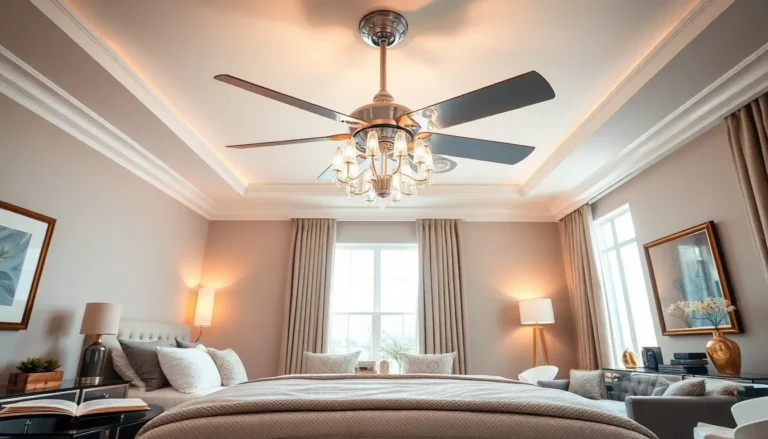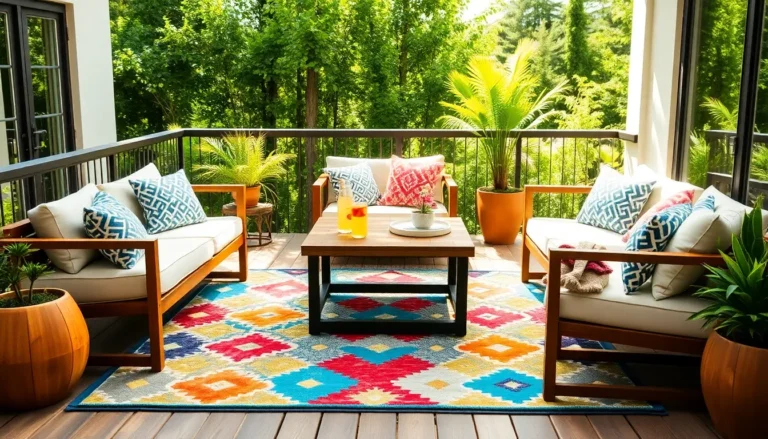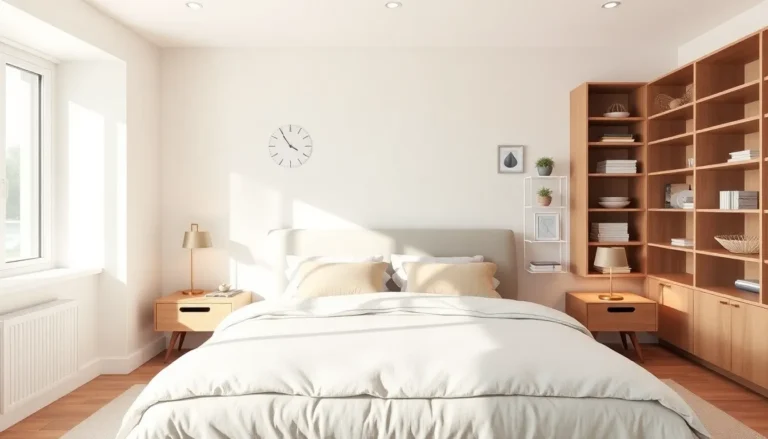Table of Contents
ToggleImagine stepping into a sanctuary where tranquility reigns and chaos takes a backseat. A zen bedroom isn’t just a place to sleep; it’s a personal retreat designed to melt away stress and usher in serenity. With the right elements in place, it can transform even the most cluttered minds into calm seas.
What Is a Zen Bedroom?
A zen bedroom functions as a personal retreat that fosters tranquility and reduces stress. This sanctuary focuses on simplicity and minimalism to promote a calming atmosphere.
Key Features of a Zen Bedroom
Simplicity characterizes the design of a zen bedroom. Neutral colors such as whites, beiges, and soft greens dominate the color palette. Furnishings remain minimal, featuring only essential pieces like a bed, bedside tables, and a comfortable chair. Natural materials like wood and cotton enhance the serene environment. Organization plays a significant role; clutter-free spaces contribute to few distractions. Additionally, soft lighting creates a welcoming ambiance, helping to maintain relaxation.
Benefits of Creating a Zen Bedroom
Reducing stress stands as a primary benefit of a zen bedroom. Such environments encourage restful sleep, leading to better overall health. Increased focus and productivity result from a peaceful space that minimizes distractions. Additionally, a zen bedroom promotes mindfulness and self-reflection, improving mental clarity. Enhanced creativity arises from a calm atmosphere conducive to inspiration. Overall, the benefits combine to foster a balanced lifestyle, supporting both physical and mental well-being.
Designing Your Zen Bedroom
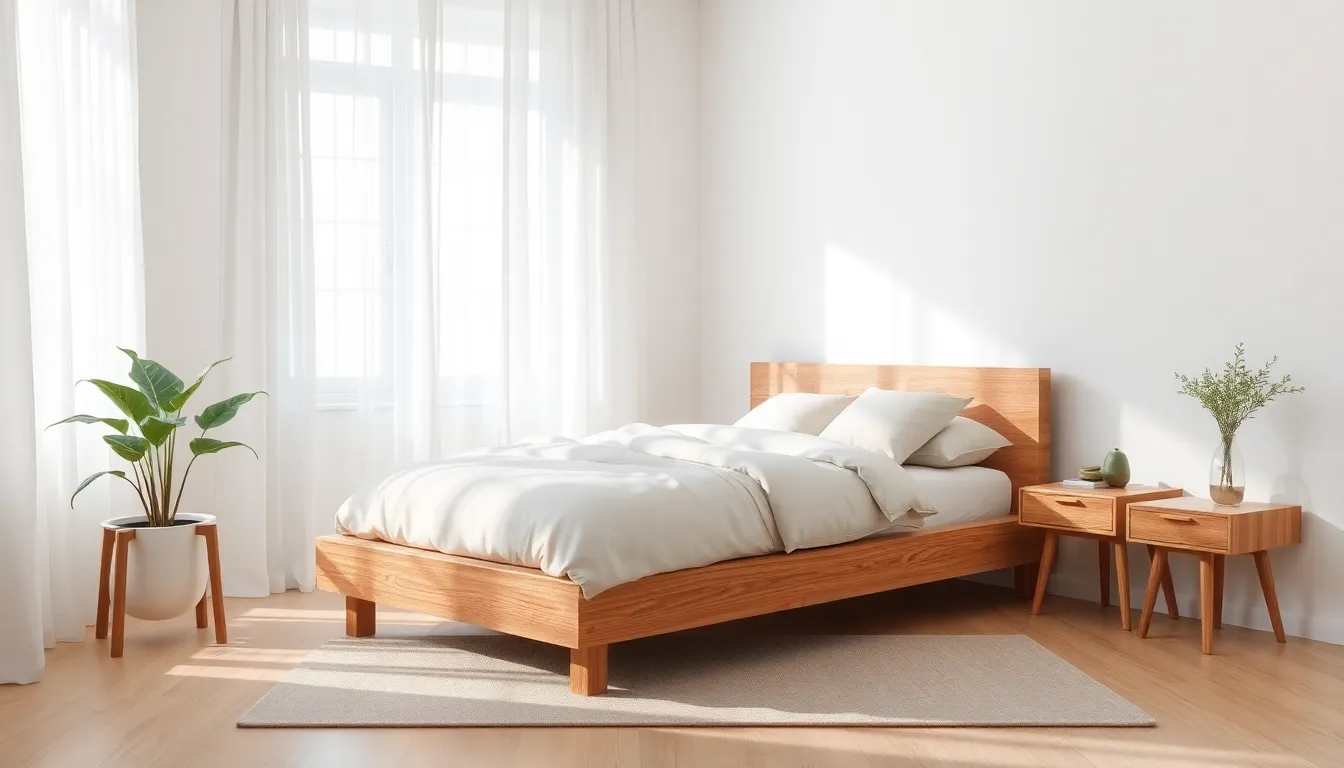
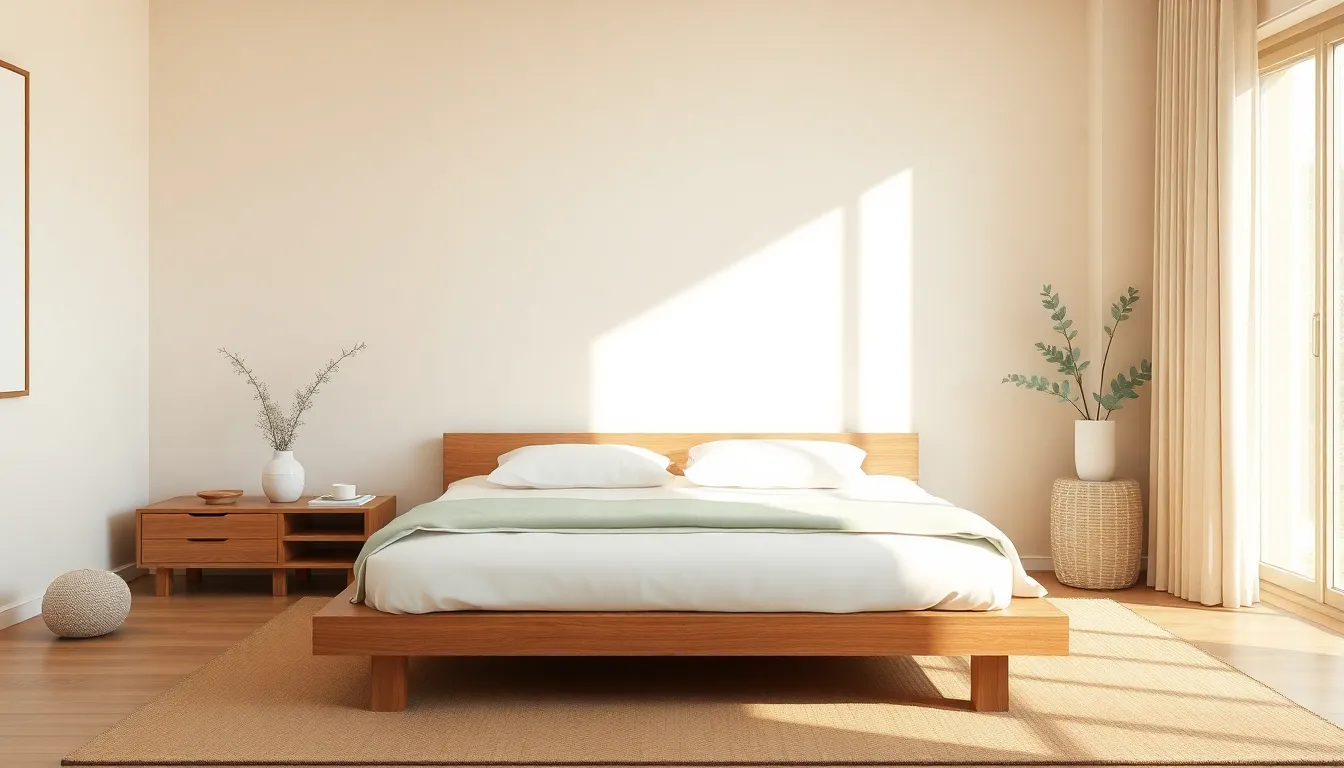
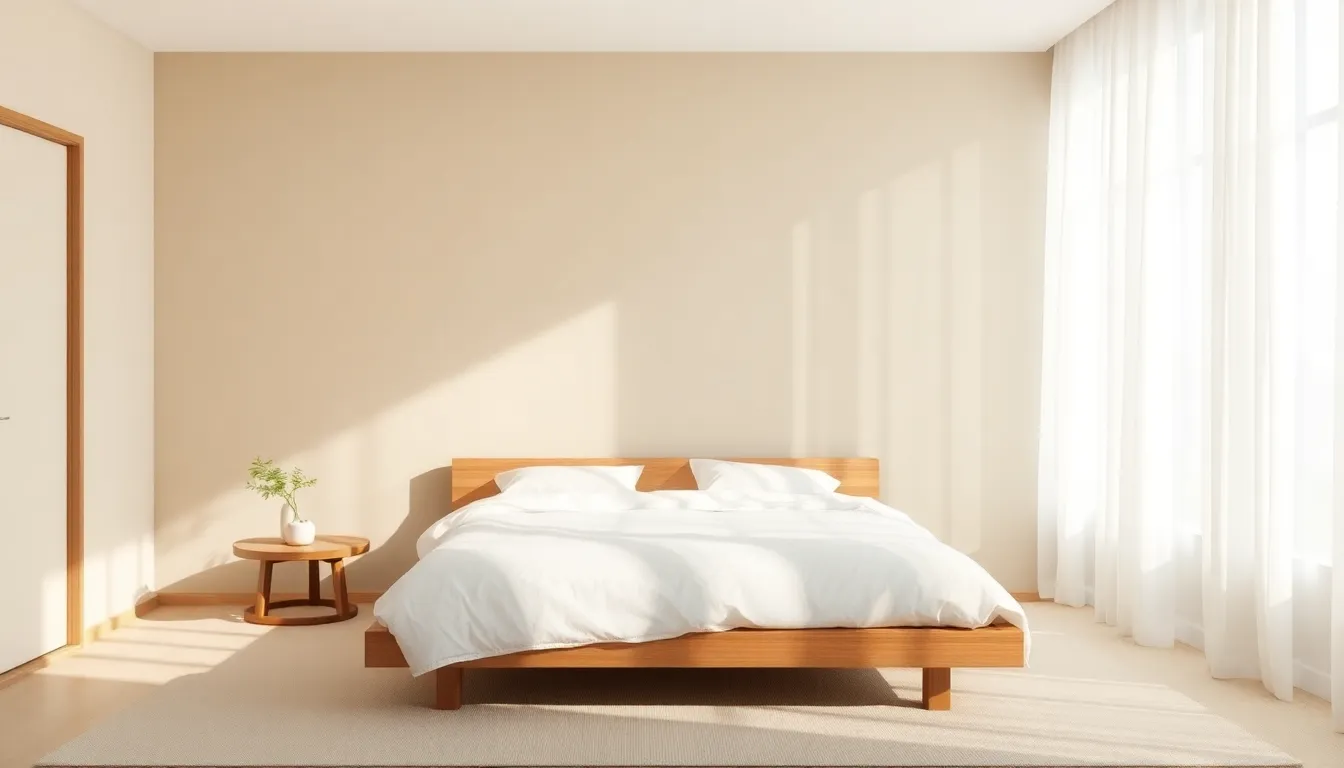
Creating a zen bedroom requires careful consideration of various elements that contribute to a serene environment. A harmonious atmosphere fosters relaxation and tranquility.
Color Palette
Neutral tones dominate a zen bedroom color palette. Soft whites, muted beiges, and gentle greens cultivate a sense of peace. Accents of warm earth tones enhance comfort and invite a natural feel. Choosing colors that resonate with personal comfort emphasizes the calming effect. Light shades brighten the space, making it feel open and inviting. Darker hues can serve as accents, providing depth without overwhelming the peaceful vibe. Combining different shades within this palette maintains a cohesive look while promoting relaxation.
Furniture Selection
Furniture selection plays a key role in achieving a zen environment. Prioritize simple designs and functional pieces to avoid visual clutter. A low-profile bed promotes a grounded feel, enhancing the tranquil atmosphere. Nightstands and chairs maintain functionality while offering clean lines. Selecting natural materials, like wood and cotton, contributes to a harmonious space. Minimalist furniture enables easy movement, facilitating a more expansive feel. Emphasizing comfort in seating encourages relaxation, further solidifying the zen experience. Choosing furniture with a purposeful arrangement creates balance, ensuring that every piece serves a specific role in the overall design.
Minimalism in a Zen Bedroom
Minimalism creates a serene atmosphere essential for a zen bedroom. It encourages simplicity and organization while fostering tranquility and focus.
Decluttering Tips
Begin by assessing the items currently in the bedroom. Remove anything that doesn’t serve a purpose or bring joy. Categorize belongings into keep, donate, or discard piles. Limit decorative elements to a few meaningful pieces. Store items in designated spaces to maintain a neat environment. Use organizers for small items to prevent clutter. Regularly revisit these arrangements to ensure the space remains calm and organized.
Essential Items to Keep
Focus on the most impactful elements. Retain a comfortable bed as the room’s centerpiece, promoting restful sleep. Include bedside tables for essential items like lamps, books, or personal effects. A cozy chair offers a place for reading or reflection, enhancing relaxation. Ensure availability of soft textiles, such as pillows and blankets, contributing to comfort. Utilize natural materials, like wood and cotton, to create warmth and a connection to nature. Keep lighting soft and adjustable to maintain a soothing ambiance.
Incorporating Nature
Incorporating nature into a zen bedroom enhances tranquility and fosters a calming atmosphere. Introducing elements from the natural world can significantly impact mental and emotional well-being.
Plants for a Zen Bedroom
Plants bring life into a zen bedroom, promoting a soothing environment. Consider adding low-maintenance varieties such as snake plants, peace lilies, and pothos, which purify air and thrive in varied light conditions. Each plant contributes its unique attributes, creating a refreshing space. Place pots on bedside tables or shelves, allowing greenery to blend seamlessly into the room. The gentle presence of foliage not only beautifies but also reduces stress levels, encourages mindfulness, and boosts overall mood.
Natural Materials
Using natural materials creates harmony and comfort in a zen bedroom. Wood, cotton, and linen are ideal choices, offering warmth and a connection to nature. Wooden furniture adds an earthy tone, while soft cotton bedding enhances relaxation. Incorporating these elements ensures a tactile and visually pleasing experience. Choose neutral color palettes to promote serenity, allowing natural textures to shine. Emphasizing simplicity and authenticity deepens the sense of peace, establishing a tranquil retreat for rest and reflection.
Creating a Relaxing Atmosphere
A calming environment supports the concept of a zen bedroom. Focusing on lighting, textiles, and layout contributes to a serene atmosphere.
Lighting Solutions
Soft lighting creates an inviting ambiance essential for relaxation. Use adjustable options like dimmer switches or lamps with warm bulbs. Focus on natural light during the day, allowing sunlight to enhance the space. Incorporate candles as an additional touch; their gentle flicker promotes tranquility. Position light sources strategically to avoid harsh shadows or bright spots. Consider layered lighting, combining overhead fixtures with task lighting for versatility. Warm, muted tones enhance comfort, creating a peaceful escape.
Soft Textiles and Bedding
Choosing luxurious bedding improves comfort significantly. Select natural fabrics like cotton and linen for breathability and softness. Incorporate various textures, such as plush pillows and cozy throws, to invite relaxation. Limit patterns to maintain a tranquil feel and promote cohesiveness in design. Use neutral colors that align with the overall zen aesthetics, creating a soothing palette. Ensure the bed remains the focal point, establishing a serene atmosphere. Prioritize quality over quantity, allowing each textile to contribute to the relaxing environment effectively.
Creating a zen bedroom is a powerful way to cultivate peace and serenity in one’s life. By embracing minimalism and incorporating natural elements, individuals can transform their sleeping spaces into true retreats. Thoughtful design choices not only enhance the aesthetic but also promote relaxation and mindfulness.
With essential furnishings and a clutter-free environment, the zen bedroom becomes a sanctuary that supports better sleep and overall well-being. The integration of soft lighting and natural materials fosters a calming atmosphere, making it easier to unwind. By prioritizing tranquility, anyone can enjoy the numerous benefits of a zen bedroom, paving the way for a more balanced and fulfilling lifestyle.

